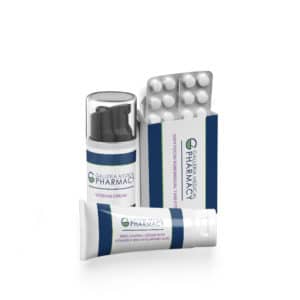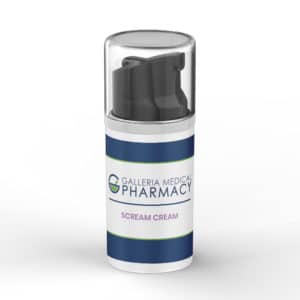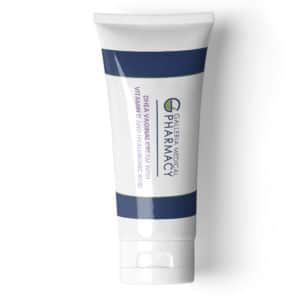Progesterone Suppositories
- Home
- /
- Products
- /
- Hormone Replacement
- /
- Progesterone Suppositories

Overview
The main purposes of progesterone are to prepare the uterus for the implantation of a fertilized egg, to maintain a pregnancy and ensure that a fetus is carried to term. Progesterone also balances the effects of estrogen and helps promote estrogen metabolism (which prevents estrogen dominance and protects the uterus). Women synthesize progesterone in the ovaries and adrenal glands. During pregnancy, it is also produced in the placenta.1, 2, 3 Men produce this hormone in the testicles and adrenal glands, only in much smaller amounts than women. In men, progesterone is important for estrogen balance and metabolism.
NOTABLE RESEARCH
Women’s Health Initiative
In 2002, the US government National Institutes of Health conducted a landmark study known as the “Women’s Health Initiative”(WHI). It compared the hormonal therapies Premarin® (0.625 mg) and Provera® (2.5 mg) with a placebo. The results showed that Premarin® and Provera®, when taken together, increased a woman’s risk of heart disease, stroke, blood clots, colon and breast cancers, fracture, and death. Premarin® taken alone also promoted these risks, though not the incidence of breast cancer.8
The Bioidentical Hormone Debate
In 2009, Dr. Kent Holtorf compiled nearly 200 peer-reviewed papers describing the effectiveness and relative safety of bioidentical hormone therapy regimens (progesterone, estradiol, and estriol) versus synthetic hormone regimens (progestins and conjugated equine estrogens) for the treatment of menopause. After citing and analyzing various positive clinical outcomes of bioidentical hormone therapy, he concluded that bioidentical hormones are both safer and more effective than synthetic hormones and are the preferred method of hormone replacement therapy. Hundreds of studies (many European) support the conclusion that BHRT is a reasonable therapeutic option for the treatment and relief of the many conditions associated with menopause.9
Endometrial Cancer Prevention
Various studies have reported that estrogen replacement therapy, whether bioidentical or not, increases the risk of endometrial cancer. Research has also shown, however, that pairing estrogen with either progesterone or a progestin decreases this risk.10-17 Therefore, it has become standard practice that women with an in-tact uterus who receive estrogen replacement therapy also take a progestogen to protect them from endometrial cancer.
Progesterone vs. Progestins
Led by Dr. Agnes Fournier, a study called “Breast Cancer Risk in Relation to Different Types of Hormone Replacement Therapy in the E3N-EPIC Cohort” looked at data on women who had used various hormone therapies from 1990 to 2002 to see whether the different types of progestogens used in HRT had produced different effects. The investigator found that women who had taken estrogen together with progesterone showed no or slight increases in breast cancer when compared with women who had not received hormone therapy. Therefore, the increased risk of breast cancer associated with supplemental estrogen may be prevented by balancing estrogen replacement therapy with bioidentical progesterone (not synthetic progestins).18
To further support Fournier’s results, in 2005, Carlo Campagnoli and his colleagues reviewed numerous studies published in the United States and Europe on the risk of breast cancer in connection with HRT. According to their consensus, combined estrogen-progestin HRT increases the risk of breast cancer in comparison with estrogen-only regimens. Progesterone, however, does not increase the risk of breast cancer.19
Indications
Progesterone is primarily used to treat secondary amenorrhea and endometrial hyperplasia.4, 5 It is also used as an infertility treatment as part of an Assisted Reproductive Technology program to prevent early pregnancy failure in women with corpus luteum insufficiency. Currently progesterone is being investigated for preterm delivery prophylaxis in high-risk women with a history of preterm delivery.6, 7 It is also used in clinical practice for the reduction of the risk of endometrial cancer in postmenopausal women receiving estrogen replacement therapy, as well as for the treatment of abnormal uterine bleeding due to hormonal imbalance.
How Supplied
Progesterone was first approved for human use in the U.S. in 1939. Today, progesterone is available commercially as oral capsules, an intravaginal gel, intravaginal insert, and intramuscular injection.20-24
Since progesterone is already commercially available as an intravaginal gel and intravaginal insert, compounded progesterone suppositories are reserved for patients that would benefit from a vaginal suppository formulation or customized dosage as determined by a prescriber. Progesterone is commonly compounded into vaginal suppositories in the following strengths:
Progesterone 50 mg Suppositories
Progesterone 200 mg Suppositories
Progesterone 300 mg Suppositories
Progesterone 400 mg Suppositories
Storage
Store this medication in its original container in a refrigerator between 35°F to 46°F (2°C – 8°C) and away from heat, moisture and light. Keep all medicine out of the reach of children. Throw away any unused medicine after the beyond use date. Do not flush unused medications or pour down a sink or drain.
Reference
- Taraborrelli, S., “Physiology, production and action of progesterone”, ACTA Obstetricia et Gynecologica, vol.94, pp. 8-16, 2015. Available: https://obgyn.onlinelibrary.wiley.com/doi/pdf/10.1111/aogs.12771
- Graham, J. D., Clarke, C.L., “Physiological Action of Progesterone in Target Tissues” Endocrine Reviews, vol.18, pp. 502-519, 1997. Available: https://academic.oup.com/edrv/article/18/4/502/2530774
- “Progesterone”, National Center for Biotechnology information, 2020. Available: https://pubchem.ncbi.nlm.nih.gov/compound/Progesterone
- “Progesterone – Drug summary”, Prescribers’ Digital Reference. Available: https://www.pdr.net/drug-summary/progesterone?druglabelid=2388
- Chandra, V., Joo-Kim, J., Benbrook, D.M., Dwivedi, A., Raj, R., “Therapeutic options for management of endometrial hyperplasia”, Journal of Gynecologic Oncology, vol.27, issue 1, Jan. 2016. Available: https://www.ncbi.nlm.nih.gov/pmc/articles/PMC4695458/
- Meis PJ, Klebanoff M, Thom E, et al. Prevention of recurrent preterm delivery by 17 alpha-hydroxyprogesterone caproate. N Eng J Med 2003;348:2379-85.
- Norwitz, E.R., Caughey, A.B., “Progesterone Supplementation and the Prevention of Preterm Birth”, Reviews in Obstetrics and Gynecology, vol.4 issue 2, pp. 60-72. 2011. Available: https://www.ncbi.nlm.nih.gov/pmc/articles/PMC3218546/
- Rossouw JE, Anderson GL, Prentice RL, et al. Risks and benefits of estrogen plus progestin in healthy postmenopausal women: principal results from the Women’s Health Initiative randomized controlled trial. JAMA. 2002;288(3):321-333.
- Holtorf K. The bioidentical hormone debate: are bioidentical hormones (estradiol, estriol, and progesterone) safer or more efficacious than commonly used synthetic versions in hormone replacement therapy? Post Grad Med. 2009;121(1):1-13.
- Beral V, Bull D, Reeves G, for the Million Women Study Collaborators. “Endometrial cancer and hormone-replacement therapy in the Million Women Study.” Lancet, 2005;365:1543-1551.2.
- Cicinelli E, de Ziegler D, Galantino P, et al. “Twice-weekly transdermal estradiol and vaginal progesterone as continuous combined hormone replacement therapy in postmenopausal women: a 1-year prospective study.” Am J Obstet Gynecol, 2002;187;556-560.3.
- Creasman WT, Henderson D, Hinshaw W, Clarke-Pearson DL. “Estrogen replacement therapy in the patient treated for endometrial cancer.”Obstet Gynecol, 1986;67:326-330.4.
- De Lignieres B. “Endometrial hyperplasia: risks, recognition and the search for a safe hormone replacement regimen.” J Reprod Med, 1999;44:191-196.5.
- Doherty JA, Cushing-Haugen KL, Saltzman BS, et al. “Long-term use of postmenopausal estrogen and progestin hormone therapies and the risk of endometrial cancer.” Am J Obstet Gynecol, 2007;197:139.e1-e7.
- Hill DA, Weiss NA, Beresford SA, et al. “Continuous combined hormone replacement therapy and risk of endometrial cancer.” Am J Obstet Gynecol, 2000;183:1456-1461.
- Persson I, Weiderpass E, Bergkvist L, Bergström R, Schairer C. Risks of breast and endometrial cancer after estrogen and estrogen-progestin replacement. Cancer Causes Control.1999;10(4):253–260.8.
- Pike MC, Ross RK. Progestins and menopause: epidemiological studies of risks of endometrial and breast cancers. Steroids 2000;65:659-64.
- Fournier, Agnès. “Breast Cancer Risk in Relation to Different Types of Hormone Replacement Therapy in the E3N-EPIC Cohort.” Int. J. Cancer, 2005; 114:448–454
- Campagnoli C, et al. “Progestins and progesterone in hormone replacement therapy and the risk of breast cancer.” J Steroid Biochem Mol Biol. 2005 Jul;96(2):95-108.
- Progesterone capsule package insert. High Point, NC: Banner Pharmacaps Inc; 2013 Nov.
- Crinone® (progesterone) vaginal gel package insert. Parsippany, NJ: Watson Pharma, Inc.; 2011 Dec.
- Prochieve® (progesterone) vaginal gel package insert. Livingston, NJ: Columbia Laboratories, Inc.; 2009 Nov.
- Endometrin® (progesterone) intravaginal insert package insert. Hunt Valley, MD: Pharmaceutics International, Inc.; 2007 Jun.
- Progesterone injection package insert. Corona, CA: Watson Laboratories, Inc.; 2007 Jan.
Compounding Pharmacy Statement
Progesterone vaginal suppositories are compounded with drug components whose suppliers are registered with the FDA. While Galleria Medical Pharmacy adheres to USP <795> guidelines and applicable state and federal regulations to meet the required quality standards, the statements made regarding compounded progesterone vaginal suppositories have not been evaluated by the FDA for safety or clinical effectiveness. As such, this preparation is not intended to diagnose, treat, cure, or prevent any disease. For inquiries concerning this preparation, please contact (504) 267-9876.





